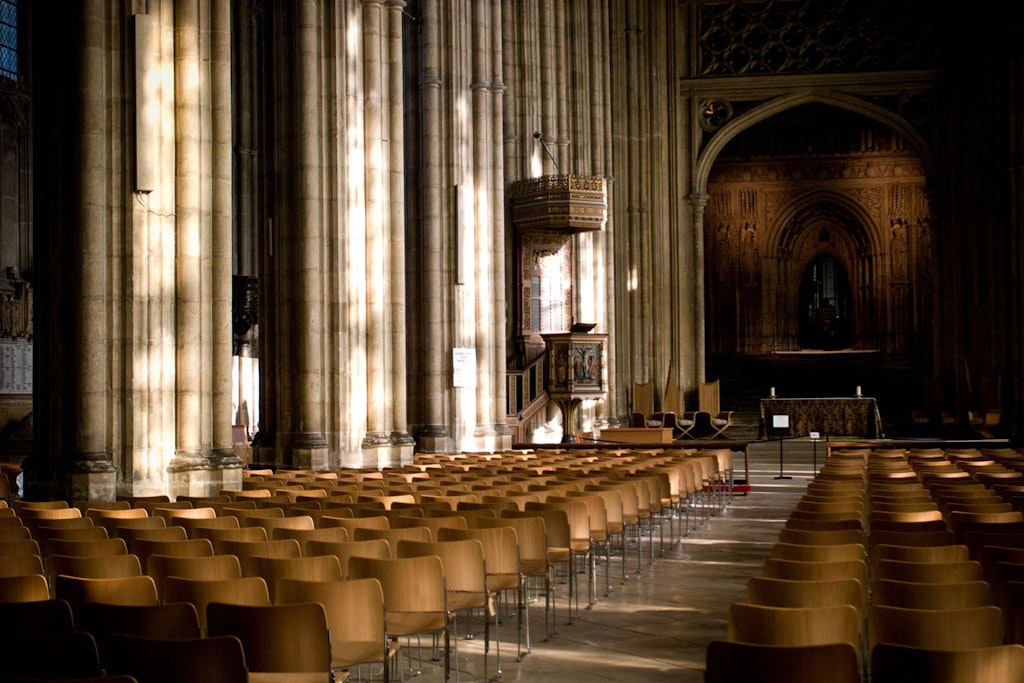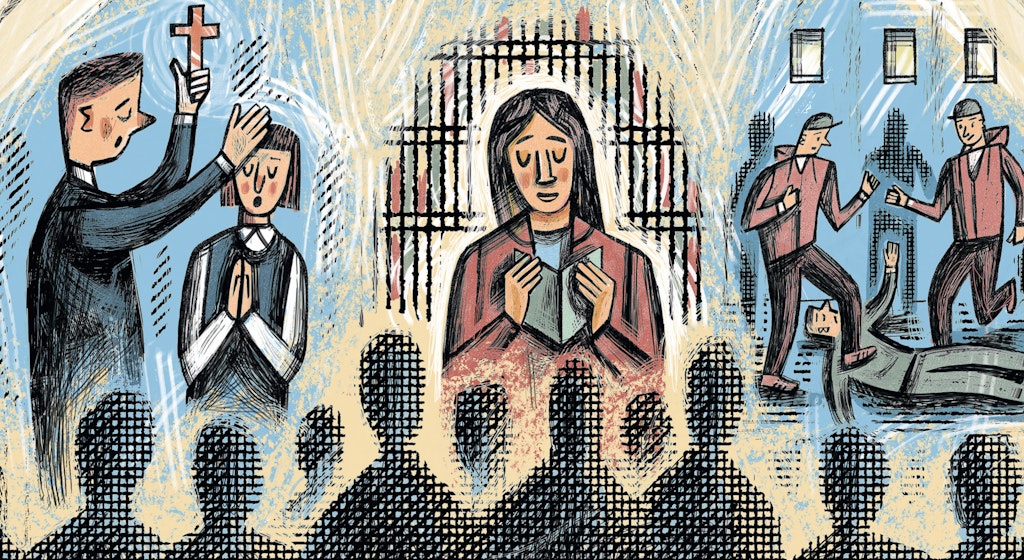Ruff day at the NEC
Crufts is less about the dogs than it is their human owners
I’d hoped that on the 08:51 out of Euston there’d be something of a party atmosphere. After all, we were on our way to the world’s greatest dog show.
I’d envisaged dancing in the aisles, free-flowing Stella, and chants about the nation’s favourite Dandie Dinmonts — “everywhere, anywhere, we will follow Duchess”. But there were eight of us in coach G and the atmosphere was studious. A group of middle aged German ladies were discussing inbreeding coefficients, an old couple wearing golden retriever facemasks pored over their show programmes, and there were two large men in tight vests with “SAY NO TO DOG MEAT” printed across them. It was good to see somebody finally taking a stand against Crufts’ famous pulled poodle stalls.
Most people agree that the National Exhibition Centre is the least sexy place in Europe and I can confirm that its ickiness is little improved by the scent of 20,000 dogs. At the turnstiles, a blue-eyed boy with a broken leg rummaged through my bag, then scanned my ticket. “It’s not the same,” he said as he waved me through, “not like it used to be.” He shook his head and I had absolutely no idea at all what he meant.
For a while I leaned on a barrier, watching the golden retrievers plodding around a rectangle of fake grass. It was standing room only and I was sandwiched between a Scotsman in a tweed suit and a plump pensioner in shorts. After a while, I leaned towards the pensioner and asked if it made any odds that three of the dogs had a russet coat while the rest were pale yellow. He smiled at me as though I’d said something filthy and leaned in for more. “It shouldn’t but it does. Some judges have a preference.”
A lot of time for the “lagotto Romagnolo” – a truffle and duck hunting dog, which according to my new pal, Geoff, “always had to be small enough to go on little boats on the Italian marshes”. 🇮🇹 🦆 pic.twitter.com/1nj0hJuQCi
— Patrick Galbraith (@PaddyCGalbraith) March 13, 2022
Blue and yellow ribbons allow your dog to display solidarity with Ukraine
Crufts was founded by the eponymous Charles Cruft, an entrepreneurial dog biscuit salesman, in 1886, and continued to be run by him until his death in 1938. Four years later, the widowed Mrs Cruft sold it to The Kennel Club, who still manage it today. The KC, being the largest and oldest kennel club in the world, is a smart establishment with a sprawling Mayfair premises, and while there were very few ladies in hats at the NEC, the event does retain a whiff of grandeur. “But you don’t see as many ties as you used to,” the Scotsman on my right lamented, when I told him how much I like the tartan pattern on his, “things change, but it’s not the spectacle it once was.”
As the dogs were prodded and poked, the Scotsman grumbled on, “When I was a young man, it was all tweed breeks and stockings, but there we are.” He gestured towards a young guy in the ring wearing a pair of jeans and shook his head sadly. When I pressed him, the tweed-trousered man told me he’d been showing two veteran dogs that hadn’t placed but he wanted to return to sartorial concerns. “Now, you see, in local shows, you might not even see a tie at all.” When I asked him his name, he recoiled as though I’d asked to see what was in those tweed trousers of his, and then told me quite reluctantly that it was “McTavish. I’m Mr McTavish.”
I turned away towards the aisles and got caught up in a riptide of waddling people holding tiny dogs in their big arms. There were stands selling sausage rolls for dogs, treadmills for dogs, blue and yellow ribbons so your dog could display solidarity with Ukraine, and a sort of emporium of canine toiletries. “Not tested on animals I hope,” I said to the man, as I picked up a bottle of tropical shampoo. He didn’t laugh and I walked away, thinking about how my Jack Russell is only truly happy when she’s rolled in badger shit.
Further on, at the entrance to the next hall, a man was sitting in a massage chair with a greasy mass of black hair in his lap. Except for the lime-green bunchies, the creature looked like a Victorian vagrant and, when I stopped to talk to it, I half expected it to turn round and ask for a couple of shillings. “She’s a princess,” the man said softly, his face scrunched in pleasure from whatever the massage chair was doing to his lumbar. “I can see that,” I replied, staring into the dog’s cloudy black eyes.
An old lady with purple makeup clipped carefully around its arsehole
When I was young, I used to tell girls that I knew everything there was to know about dogs. It wasn’t total bullshit (and it sometimes worked) but in truth my knowledge tended to be terrier-related. In Hall 6, I was broadsided by the reality of my ignorance when I came upon 30 dogs, the like of which I’d never seen before. They were all about cocker spaniel size and had tightly curled coats like sheep. Some were cream, some were dark and some had patches of different colours that appeared to be layered on top of each other. In a thick Lancashire tone with the odd word of Italian, a man who later told me was called Geoff explained that they were “lagotto romagnolos. Duck hunting dogs. Plenty small enough to sit on boats and they use them to hunt truffles”. As he talked, the lagotto at his feet started to whine. Geoff told me proudly that the previous year, he’d taken little Sybil to Emilia Romagna so she could try her hand at the very thing she was intended to do. “Must have found about five hundred quid’s worth of truffles. Just brilliant.” We stood quietly together, watching the dogs being made to trot in circles inside the pen. I asked Geoff how many of them would have seen action in the field. “I shouldn’t say many at all,” he replied.
By the door a poodle was perched high on a sort of metal operating table while an old lady with purple makeup clipped carefully around its arsehole. On tiptoes it tottered restlessly. It was hard to see its eyes behind its thick white bunches, but when I crouched down I could just make them out, dark brown and forlorn. “Gorgeous,” a man in a white leather jacket whispered as he walked past.
Not on board with this really. The poodle looks miserable. It wants to be out there, in the field, like its ancestors. Let dogs be dogs 🐩 pic.twitter.com/Ezn8OV5Zpu
— Patrick Galbraith (@PaddyCGalbraith) March 13, 2022
On the train home, I watched the soft early-spring fields rush by. I wanted to like Crufts; it was camp in an earthy way that I sort of imagine only England can do. Beyond the window there were hares, woodpigeons, and roe deer. There were countless kites and I saw a kestrel hunting voles among the winter wheat. Wild creatures are beautiful because we never really understand them. You never really know where the snipe will fall in winter or whether the lapwings will return in spring.
I suppose dogs were like that some 20,000 years ago, roaming free until we tamed them and, in doing so, broke the spell. To be human is to want control. In many cases it’s a happy relationship; collies love working sheep, hounds love questing through the trees for truffles and pointers are at their happiest hunting grouse among the heather. But Crufts is human solipsism at its saddest, with thousands of dogs carefully bred to delight the judges with form rather than function — bow-backed Bedlington terriers, golden retrievers so heavy set that a day on the hill would finish them off, and pugs with such winning faces they can hardly breathe.
When Aleggra (the lagotto romagnolo I’ve resolved to get) comes, I won’t be pitting her against others to be judged on the size of her head or the distinctness of the furrow between her eyes. We’re going to do things her way; in autumn, we’ll drive down to Tuscany so she can find truffles and then, when the snow blows in, we’ll go east to the Delta del Po to hunt ducks. Cruel as hell, some would have you believe, but surely letting dogs do what they want to do is a great act of kindness, rather than turning them into freaks and putting them on parade in pursuit of silverware.
Enjoying The Critic online? It's even better in print
Try five issues of Britain’s newest magazine for £10
Subscribe














